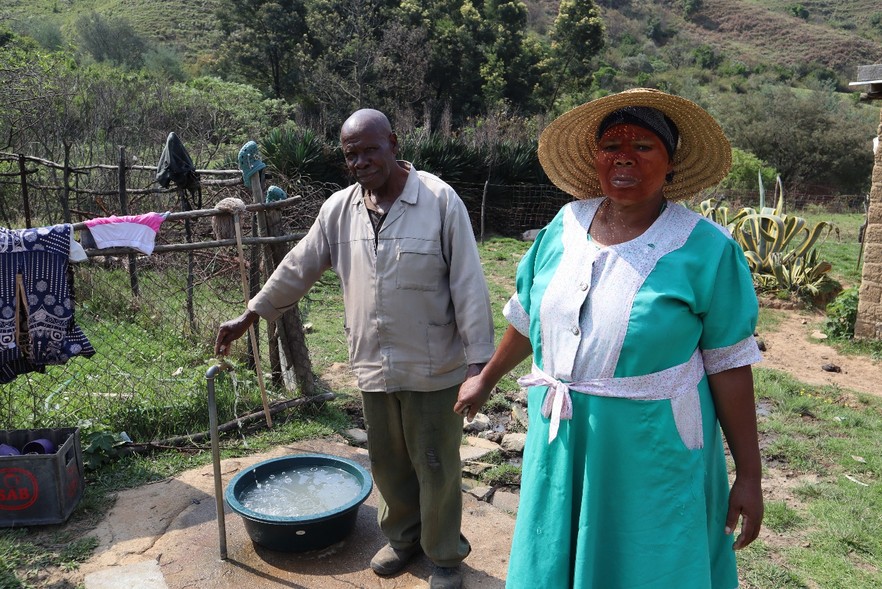
27 October 2025
Mphikeleli Hlatshwayo and Matotozi Thulabezwe and the tap for their personal water scheme, which draws water from a fountain atop the hill in the background. Photos: Sean Christie
In 2004 Mphikeleli “Qubile” Hlatshwayo left his job in a Kempton Park muti shop and moved to a village in Ogade on the border between KwaZulu-Natal and the Free State. On arrival, he and his family faced a challenge that many people in rural areas encounter: the nearest water source, a community well, was located over a kilometer away from his home. There is a river which is closer, but the quality of the water is poor.
“We drank with the animals,” Hlatshwayo, now 78, said.
Ogade overlooks Woodstock Dam, which supplies water to Johannesburg as part of the Thukela-Vaal inter-basin transfer scheme. However, none of the villages around the dam receive water from it. In Okhahlamba local municipality, which they fall under, one in two households is without water.
Rather than wait for the authorities to address their water issues, Hlatshwayo took matters into his own hands in 2022.
“There is a mountain behind us, and at the top I found a fountain,” he said.
Returning on horseback with a shovel and cement, Hlatshwayo dug a trench and redirected water from the fountain into a water course on his side of the hill, bringing it directly alongside his house. A short pipeline takes the water to a rain tank, which connects to a tap in his yard.
“The water is very pure, and it never runs out,” he said.
Hlatshwayo has spent about R15,000 on his water scheme to date, but as a result, his family has access to high quality drinking water all year round.
The project, which used several bags of cement and eight sections of pipe, cost Hlatshwayo approximately R15,000. Since completing it in 2022, Hlatshwayo has had to replace two pipes. Neighbours are constantly coming over to draw water from Hlatshwayo’s scheme, which he believes could easily be extended to the wider community, including nearby Hoye High School and Ogade Primary School.
“I have learned in my life to take responsibility for the needs of my family. If you wait for help, you can wait too long,” he said.
Wilfred Mole has lived on a family property in the Midrand’s Carlswald valley since 1959. It was bought to graze cattle. As the area densified, with property developments spreading across northern Johannesburg at an extraordinary rate, Mole — a successful businessman, and since 1996 a farmer in the eastern Free State — kept the property intact: a large, sloping tract of highveld grassland, dotted with willow-fringed dams.
In 2010 the valley’s inadequate and poorly planned sewer line failed, decanting sewage into Mole’s dams, killing thousands of yellowfish. Mole had been warning Johannesburg Water about the potential disaster for years, to no avail.
The dam that Wilfred Mole built on his property, to hold sewage spills in Midrand’s Carlswald Valley.
Rather than see the property coated in sewage again, Mole constructed a large sewage holding dam. In its earth wall he installed a bypass system controlled by a valve that can be opened when the level rises too high. A concrete channel carries released water to a manhole on the property, and decants back into a sewer line lower down.
“Because we have so many sewage breaks along the Carlswald sewer line, and because it has such a devastating effect on our property, killing all lifeforms in all the lakes, wetlands and weirs we constructed, we were forced to put in place a strategy which helped us to defend the property against these pollution levels. The only way we could do that was to build a dam that would temporarily hold the sewage, preventing it from carrying on downstream,” said Mole.
As the area has densified further, the sewage spills have become more frequent.
Sewage spills in Carlswald Valley caused a die-off of a yellowfish in Mole’s dams. Sewage has flooded his neighbours’ homes and swimming pools.
“It’s a weekly occurrence now,” said Mole, who has broadened and lifted the wall of his holding dam to increase its capacity. He has also established a series of smaller attenuation dams down the length of his property, interspersed with wetlands, in an effort to slow the stormwater flooding through the valley’s property whenever it rains.
In total, Mole estimates he has spent in excess of a R1-million in materials alone to safeguard his property from sewage spills and stormwater surges – both consequences of development without proper planning or maintenance of the inadequate, outdated sewer.
A 60-metre bypass channel takes excess sewage from Mole’s holding dam to a manhole on his property, where it decants back into the sewer line.